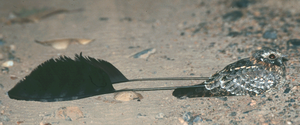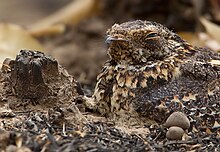Flag nightjar
| Flag nightjar | ||||||||||
|---|---|---|---|---|---|---|---|---|---|---|

Male flag night swallow |
||||||||||
| Systematics | ||||||||||
|
||||||||||
| Scientific name | ||||||||||
| Caprimulgus longipennis | ||||||||||
| Shaw , 1796 |
The flag nightjar or flag wing ( Caprimulgus longipennis , syn .: Macrodipteryx longipennis ) is an afrotropic nightjar that is named after the male's inner hand- wing feathers, which are greatly elongated during the breeding season .
features
The flag nightjar is a medium-sized, brown to gray-brown nightjar. There are no conspicuous white spots on the wings or tail. The male is unmistakable in the breeding dress due to the magnificent feathers. Together with the flag night swallow ( Caprimulgus vexillarius ), which shows similar characteristics in the plumage of the males, the flag night swallow was placed in its own genus Macrodipteryx for a long time , but after molecular genetic comparisons it was again included in the genus goat milkers ( Caprimulgus ) from 2010 .
Occurrence
The flag nightjar breeds in West to Central Africa ( Senegal to Ethiopia ). Outside of the breeding season, it moves to the more northerly savannas of the Sahel and Sudan . It prefers thinly forested thorn and shrub savannas.
behavior
The flag nightjar, like all nightjars, is active at night and at dawn. She spends the day sitting on the floor, where she can hardly be seen due to her good camouflage. After dusk it hunts moths, beetles and other flying insects. It has also been observed to catch insects startled by forest fires.
Reproduction
The male's ornamental feathers, which are up to 50 cm long, consist of a long, thin shaft that only widens to a flag shortly before the tip. Several males and females gather in an arena in which the males perform their courtship flight with vibrating wings and raised flag feathers. After the mating season, the feathers fall out again. One or two eggs are incubated in a light, natural hollow on the bare bottom.
Individual evidence
- ↑ Kin-Lan Han, Mark B. Robbins & Michael J. Braun: A multi-gene estimate of phylogeny in the nightjars and nighthawks (Caprimulgidae). Molecular Phylogenetics and Evolution, 55, 2, pp. 443-453, May 2010
Web links
- Caprimulgus longipennis in the endangered Red List species the IUCN 2008. Posted by: BirdLife International, 2008. Accessed on December 22 of 2008.
- Videos, photos and sound recordings for Macrodipteryx longipennis in the Internet Bird Collection
